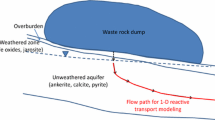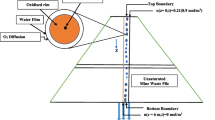Abstract
A previously developed two-dimensional numerical model is further developed for simulating the transport of dissolved contaminants originating from dissolution of a coal tar pool in a stratified, saturated porous medium. The model is used to simulate contaminant transport resulting from a rectangular-shaped coal-tar-pool dissolution experiment conducted in a large-scale experimental aquifer. The experimental porous medium consists of two sand strata, a high-hydraulic-conductivity upper stratum and a low-hydraulic-conductivity bottom stratum. The experiment was conducted to a time of 354 days and the groundwater velocity was changed several times within this duration. Model simulations show good agreement against observed contaminant concentrations, and simulations show that dissolved solute below the pool migrated deeper into the bottom stratum as compared to the upper stratum. Furthermore, simulations also suggest that contaminant concentrations in the lower stratum never reached quasi steady-state during the experimental time frame.
Résumé
Un modèle 2D numérique construit précédemment est développé plus en avant pour simuler le transport de contaminants dissous originaires de la dissolution d’un gisement de goudron de houille dans un milieu poreux stratifié et saturé. Le modèle est utilisé pour simuler le transport de contaminant résultant d’une expérience de dissolution d’un gisement rectangulaire de goudron de houille, conduite dans un aquifère expérimental à large échelle. Le milieu poreux expérimental consiste en deux strates de sables: une à forte conductivité hydraulique dans la strate la plus élevée, et une à basse conductivité hydraulique dans la strate la plus basse. L’expérience a été conduite durant 354 jours et la vitesse de l’eau souterraine a variée plusieurs fois durant cette période. Les simulations du modèle montrent une bonne concordance avec les concentrations observées en contaminant; elles montrent aussi que le soluté dissout sous le gisement descend plus profondément dans la strate la plus basse, comparée à la strate la plus haute. De plus, les simulations suggèrent également que les concentrations en contaminant dans la strate la plus basse n’atteignent jamais un état quasi-permanent durant le temps d’expérimentation.
Resumen
Un modelo numérico en dos dimensiones desarrollado previamente ha sido rediseñado para simular el transporte de contaminantes disueltos cuyo origen es la disolución de una balsa de alquitrán en un medio estratificado, saturado y poroso. El modelo se ha utilizado para simular el transporte de contaminantes resultante de la disolución de una balsa de alquitrán de forma rectangular en un acuífero experimental a gran escala. El medio poroso experimental consiste en dos estratos de arena, uno superior con una conductividad alta y otro inferior con baja conductividad. El experimento se llevó a cubo durante 354 días y la velocidad del agua subterránea se cambió varias veces durante este tiempo. Las simulaciones del modelo presentan una buena correlación con las concentraciones observadas de contaminante, y muestran que el soluto disuelto bajo la balsa migró más profundamente dentro del estrato inferior comparativamente con el estrato superior. Además, las simulaciones también apuntaban a que las concentraciones de contaminante en el estrato inferior no alcanzaban nunca el estado casi estacionario durante el tiempo de experimentación.





Similar content being viewed by others
References
Brown DG, Knightes CD, Peters CA (1999) Risk assessment for polycyclic aromatic hydrocarbon NAPLs using component fractions. Environ Sci Technol 33:4357–4363
Chrysikopoulos CV, Lee KY (1998) Contaminant transport resulting from multicomponent nonaqueous phase liquid pool dissolution in three-dimensional subsurface formations. J Contam Hydrol 31:1–21
Chrysikopoulos CV, Lee KY, Harmon TC (2000) Dissolution of a well-defined trichloroethylene pool in saturated porous media: experimental design and aquifer characterization. Water Resour Res 36:1687–1696
Dabestani R, Ivanov IN (1999) A compilation of physical, spectroscopic and photophysical properties of polycyclic aromatic hydrocarbons. Photochem Photobiol 70:10–34
de Marsily G (1986) Quantitative hydrogeology, groundwater hydrology for engineers. Academic Press, San Diego, CA
Dong J, Chowdhry B, Leharne S (2004) Investigation of the wetting behavior of coal tar in three phase systems and its modification by poloxamine block copolymeric surfactants. Environ Sci Technol 38:594–602
Eberhardt C, Grathwohl P (2002) Time scales of organic contaminant dissolution from complex source zones: coal tar pools vs. blobs. J Contam Hydrol 59:45–66
Hashimoto I, Deshpande KB, Thomas HC (1964) Peclet numbers and retardation factors for ion exchange columns. Ind Engr Chem Fund 3:213–218
Hayduk W, Laudie H (1974) Prediction of diffusion coefficients for nonelectrolytes in dilute aqueous solutions. AIChE J 20:611–615
Karickhoff SW (1984) Organic pollutant sorption in aquatic systems. J Hydraul Eng ASCE 110:707–735
Khodadoust AP, Lei L, Antia JE, Bagchi R, Suidan MT, Tabak HH (2005) Adsorption of polycyclic aromatic hydrocarbons in aged harbor sediments. J Environ Eng ASCE 131:403–409
King MWG, Barker JF (1999) Migration and natural fate of a coal tar creosote plume. 1. Overview and plume development. J Contam Hydrol 39:249–279
Lee KY (2004) Modeling long-term transport of contaminants resulting from dissolution of a coal tar pool in saturated porous media. J Environ Eng ASCE 130:1507–1513
Lee KY, Chrysikopoulos CV (1998) NAPL pool dissolution in stratified and anisotropic porous formations. J Environ Eng ASCE 124:851–862
Lee KY, Chrysikopoulos CV (2006) Dissolution of a multicomponent DNAPL pool in an experimental aquifer. J Hazard Mater B128:218–226
Loibner AP, Szolar OHJ, Braun R, Hirmann D (2004) Toxicity testing of 16 priority polycyclic aromatic hydrocarbons using Lumistox. Environ Toxicol Chem 23:557–564
Mueller JG, Chapman PJ, Pritchard PH (1989) Creosote-contaminated sites: their potential for bioremediation. Environ Sci Technol 23:1197–1201
Ortiz E, Kraatz M, Luthy RG (1999) Organic phase resistance to dissolution of polycyclic aromatic hydrocarbon compounds. Environ Sci Technol 33:235–242
Peters CA, Mukherji S, Knightes CD, Weber WJ (1997) Phase stability of multicomponent NAPLs containing PAHs. Environ Sci Technol 31:2540–2546
Sverdrup LE, Nielsen T, Krogh PH (2002) Soil ecotoxicity of polycyclic aromatic hydrocarbons in relation to soil sorption, lipophilicity, and water solubility. Environ Sci Technol 36:2429–2435
Tiruta-Barna L, Mahjoub B, Faure L, Hanna K, Bayard R, Gourdon R (2006) Assessment of the multi-compound non-equilibrium dissolution behavior of a coal tar containing PAHs and phenols into water. J Hazard Mater B132:277–286
Acknowledgments
This study was partially funded by a research grant from the West Virginia University Institute of Technology Foundation. The authors would like to thank Ms. Jessica Kruczek for contributing to the simulations.
Author information
Authors and Affiliations
Corresponding author
Rights and permissions
About this article
Cite this article
Lee, K.Y., Khinast, J. & Kim, JH. Numerical modeling of contaminant transport resulting from dissolution of a coal-tar pool in an experimental aquifer. Hydrogeol J 15, 705–714 (2007). https://doi.org/10.1007/s10040-006-0144-y
Received:
Accepted:
Published:
Issue Date:
DOI: https://doi.org/10.1007/s10040-006-0144-y




